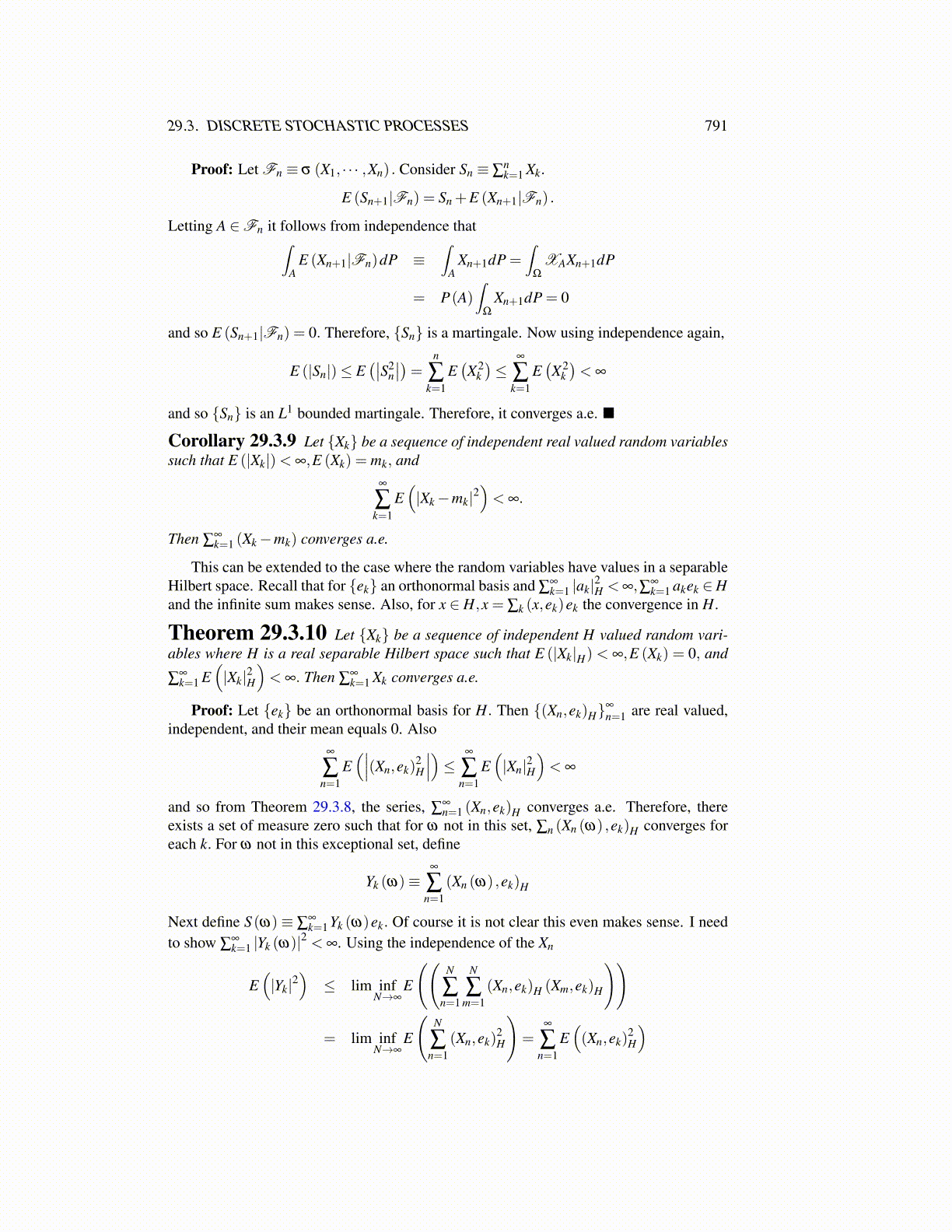
29.3. DISCRETE STOCHASTIC PROCESSES 791
Proof: Let Fn ≡ σ (X1, · · · ,Xn) . Consider Sn ≡ ∑nk=1 Xk.
E (Sn+1|Fn) = Sn +E (Xn+1|Fn) .
Letting A ∈Fn it follows from independence that∫A
E (Xn+1|Fn)dP ≡∫
AXn+1dP =
∫Ω
XAXn+1dP
= P(A)∫
Ω
Xn+1dP = 0
and so E (Sn+1|Fn) = 0. Therefore, {Sn} is a martingale. Now using independence again,
E (|Sn|)≤ E(∣∣S2
n∣∣)= n
∑k=1
E(X2
k)≤
∞
∑k=1
E(X2
k)< ∞
and so {Sn} is an L1 bounded martingale. Therefore, it converges a.e. ■
Corollary 29.3.9 Let {Xk} be a sequence of independent real valued random variablessuch that E (|Xk|)< ∞,E (Xk) = mk, and
∞
∑k=1
E(|Xk−mk|2
)< ∞.
Then ∑∞k=1 (Xk−mk) converges a.e.
This can be extended to the case where the random variables have values in a separableHilbert space. Recall that for {ek} an orthonormal basis and ∑
∞k=1 |ak|2H < ∞,∑∞
k=1 akek ∈Hand the infinite sum makes sense. Also, for x ∈ H,x = ∑k (x,ek)ek the convergence in H.
Theorem 29.3.10 Let {Xk} be a sequence of independent H valued random vari-ables where H is a real separable Hilbert space such that E (|Xk|H) < ∞,E (Xk) = 0, and
∑∞k=1 E
(|Xk|2H
)< ∞. Then ∑
∞k=1 Xk converges a.e.
Proof: Let {ek} be an orthonormal basis for H. Then {(Xn,ek)H}∞
n=1 are real valued,independent, and their mean equals 0. Also
∞
∑n=1
E(∣∣∣(Xn,ek)
2H
∣∣∣)≤ ∞
∑n=1
E(|Xn|2H
)< ∞
and so from Theorem 29.3.8, the series, ∑∞n=1 (Xn,ek)H converges a.e. Therefore, there
exists a set of measure zero such that for ω not in this set, ∑n (Xn (ω) ,ek)H converges foreach k. For ω not in this exceptional set, define
Yk (ω)≡∞
∑n=1
(Xn (ω) ,ek)H
Next define S (ω)≡ ∑∞k=1 Yk (ω)ek. Of course it is not clear this even makes sense. I need
to show ∑∞k=1 |Yk (ω)|2 < ∞. Using the independence of the Xn
E(|Yk|2
)≤ lim inf
N→∞E
((N
∑n=1
N
∑m=1
(Xn,ek)H (Xm,ek)H
))
= lim infN→∞
E
(N
∑n=1
(Xn,ek)2H
)=
∞
∑n=1
E((Xn,ek)
2H
)